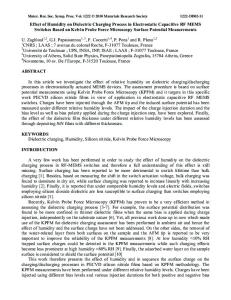Dielectric Charging in Low Temperature Silicon Nitride for RF-MEMS Capacitive Switches
- PDF / 618,122 Bytes
- 7 Pages / 612 x 792 pts (letter) Page_size
- 40 Downloads / 300 Views
1075-J05-05
Dielectric Charging in Low Temperature Silicon Nitride for RF-MEMS Capacitive Switches Richard Daigler1, George Papaioannou2, Eleni Papandreou2, and John Papapolymerou1 1 School of Electrical and Computer Engineering, Georgia Institute of Technology, 777 Atlantic Drive NW, Atlanta, GA, 30332 2 Physics, Solid State Physis Section, University of Athens, Panepistimiopolis - Zografos, Athens, 15784, Greece
ABSTRACT The paper presents a systematic investigation of dielectric charging in low temperature silicon nitride for RF-MEMS capacitive switches. The investigation takes includes both the effect of dielectric film thickness as well as the effect of metal contacts. The investigation demonstrates that the charging process is asymmetric. It is shown that the amount of stored charge depends significantly on the dielectric film thickness, which is caused from the contribution of the space charge polarization mechanism. Finally, the results are compared with those of higher temperature silicon nitride. INTRODUCTION Capacitive RF MEMS switches are one of the most promising applications in microelectromechanical systems (MEMS). In spite of this, their commercialization is still hindered by reliability problems regardless of almost 10 years studies by a lot of laboratories and companies. The most important reliability problem is the charging of the dielectric [1, 2]. On the way to solve the problem of dielectric charging, several materials have been investigated, such as oxides (SiO2, Al2O3, Ta2O5 etc) [3-7] and nitrides (Si3N4 and AlN) [8-14]. Among those the most intensively investigated ones are the SiO2 and Si3N4. In contrast to the great experience on their electrical properties, stemming from semiconductor technology, these materials still cannot provide a successful solution on the problem of dielectric charging. This can be attributed to the fact that in MEMS the dielectric films are deposited on rough substrates, the low temperatures, that lead to significant deviation from material stecheometry and the presence of hydrogen introduced during growth. The charging of the dielectric film arises from dipoles orientation and charge trapping that occurs under the strong electric field during the ON state of MEMS switches [12]. Recent experiments have shown that the charge injection mechanism is dominated by the Poole-Frenkel effect [15]. On the other hand it has been shown that in the case of silicon nitride the injected holes introduce metastable traps [16, 17]. These metastable defects affect the charge transport in the dielectric [18] and the Poole-Frenkel coefficient [19]. Finally, the defects introduced in αSi:H are expected to take place also in SiN, due to strong deviation from stecheometry [17, 20], and give rise to asymmetrical current-voltage characteristic in symmetrical Metal-InsulatorMetal capacitors [20].
In view of these problems the aim of the present work is to investigate the electrical properties of low temperature silicon nitride and compare them with those of conventional, for MEMS, one.
Data Loading...




